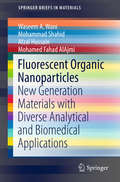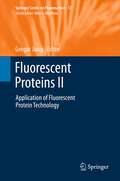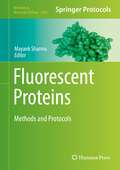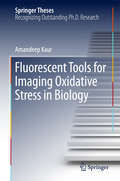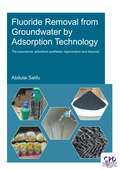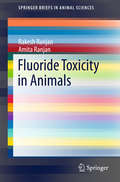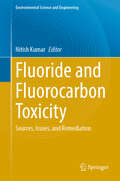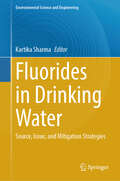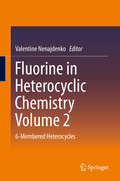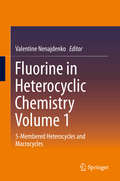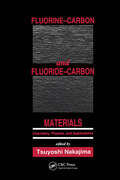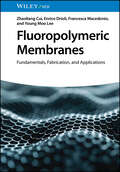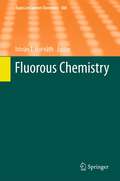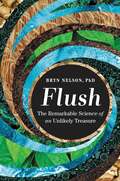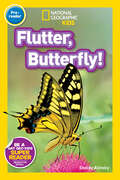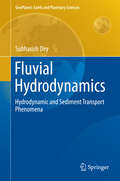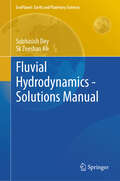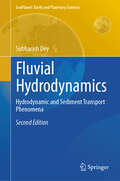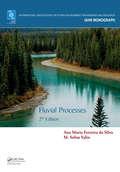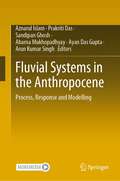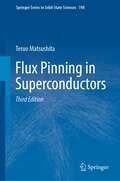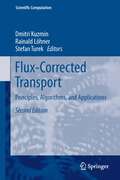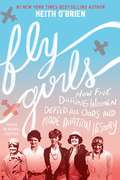- Table View
- List View
Fluorescent Organic Nanoparticles: New Generation Materials with Diverse Analytical and Biomedical Applications (SpringerBriefs in Materials)
by Waseem A. Wani Mohammad Shahid Afzal Hussain Mohamed Fahad AlAjmiThis book provides a critical review of recent advances in the development of fluorescent organic nanoparticles as materials of choice for the design and fabrication of sensors, bioimaging agents and drug delivery systems. The properties and functions of nanoparticles differ significantly from those of their parent entities or their bulk phases. Two of their most important features are their increased surface-to volume ratio, and the formation of surface structures differing from those in their bulk phases. In addition, the book discusses the synthesis of fluorescent conjugated polymers, self-assembled fluorescent nanoparticles, polydopamine nanoparticles, and aggregation-induced-emission or aggregation-induced-emission enhancement nanomaterials. In closing, the book provides an outlook on future research and development in fluorescent organic nanoparticles as smart materials with an impressive range of potential applications.
Fluorescent Proteins I
by Gregor JungFluorescent proteins are intimately connected to research in the life sciences. Tagging of gene products with fluorescent proteins has revolutionized all areas of biosciences, ranging from fundamental biochemistry to clinical oncology, to environmental research. The discovery of the Green Fluorescent Protein, its first, seminal application and the ingenious development of a broad palette of fluorescence proteins of other colours, was consequently recognised with the Nobel Prize for Chemistry in 2008. Fluorescent Proteins I is devoted to the basic photophysical and photochemical aspects of fluorescent protein technology. Experienced experts highlight colour tuning, the exploration of switching phenomena and respective methods for their investigation. The book provides a thorough understanding of primary molecular processes allowing the design of fluorescent proteins for specific applications.
Fluorescent Proteins: Methods and Protocols (Methods in Molecular Biology #2564)
by Mayank SharmaThis volume brings together cutting-edge laboratory protocols to characterize the novel fluorescent proteins (FPs) and approaches based on fluorescent proteins that aim to answer some of the key cell biological questions. The book covers topics ranging from the database of fluorescent proteins to their characterization and adaptation to a wide range of biological systems. Written for the highly successful Methods in Molecular Biology series, chapters include introductions to their respective topics, lists of the necessary materials and reagents, step-by-step and readily reproducible laboratory protocols, and tips on troubleshooting and avoiding known pitfalls. Authoritative and practical, Fluorescent Proteins: Methods and Protocols serves as an ideal guide for students and academicians enthusiastic about the recent progress in the practical application of fluorescent protein technology.
Fluorescent Tools for Imaging Oxidative Stress in Biology (Springer Theses)
by Amandeep KaurThis thesis advances the long-standing challenge of measuring oxidative stress and deciphering its underlying mechanisms, and also outlines the advantages and limitations of existing design strategies. It presents a range of approaches for the chemical synthesis of fluorescent probes that detect reversible changes in cellular oxidative stress. The ability to visualise cellular processes in real-time is crucial to understanding disease development and streamline treatment, and this can be achieved using fluorescent tools that can sense reversible disturbances in cellular environments during pathogenesis. The perturbations in cellular redox state are of particular current interest in medical research, since oxidative stress is implicated in the pathogenesis of a number of diseases.The book investigates different strategies used to achieve ratiometric fluorescence output of the reversible redox probes, which nullify concentration effects associated with intensity-based probes. It also describes suitable approaches to target these probes to specific cellular organelles, thereby enabling medical researchers to visualise sub-cellular oxidative stress levels, and addressing the typically poor uptake of chemical tools into biological studies. In total it reports on four new probes that are now being used by over twenty research groups around the globe, and two of which have been commercialised. The final chapters of this thesis demonstrate successful applications of the sensors in a variety of biological systems ranging from prokaryotes to mammalian cells and whole organisms. The results described clearly indicate the immense value of collaborative, cross-disciplinary research.
Fluoride Removal from Groundwater by Adsorption Technology
by Abdulai SalifuIn the Eastern corridor of Northern region of Ghana, presence of high fluoride concentration in the groundwater has made many drilled boreholes unusable for drinking. Little is, however, known about the factors contributing to the occurrence of high fluoride in this part of Ghana and it’s spatial distribution. Treatment of the fluoride-contaminated groundwater by adsorption is also hampered by the lack of suitable adsorbents that are locally available. Based on principal component analysis, and saturation indices calculations, this thesis highlights that, the predominant mechanisms controlling the fluoride enrichment probably include calcite precipitation and Na/Ca exchange processes, both of which deplete Ca from the groundwater, and promote the dissolution of fluorite. The mechanisms also include F-/OH- anion exchange processes, as well as evapotranspiration processes which concentrate the fluoride ions, hence increasing its concentration in the groundwater. Spatial mapping showed that the high fluoride groundwaters occur predominantly in the Saboba, Cheriponi and Yendi districts. The thesis further highlights that, modifying the surface of indigenous materials by an aluminium coating process, is a very promising approach to develop a suitable fluoride adsorbent. Aluminum oxide coated media reduced fluoride in water from 5. 0 ± 0.2 mg/L to ≤ 1.5 mg/L (which is the WHO health based guideline for fluoride), in both batch and continuous flow column experiments in the laboratory. Kinetic and isotherm studies, thermodynamic calculations, as well as analytical results from Fourier Transform Infrared Spectroscopy and Raman spectroscopy, suggest the mechanism of fluoride adsorption onto aluminium oxide coated media involved both physisorption and chemisorption processes. Field testing in a fluoritic community in Northern Ghana showed that the adsorbent is also capable of treating fluoride-contaminated groundwater in field conditions, suggesting it is a promising defluoridation adsorbent. The adsorbent also showed good regenerability potential that would allow re-use, which could make it practically and economically viable. Additional research is, however, required to further increase the fluoride adsorption capacity of developed adsorbent.
Fluoride Toxicity in Animals
by Rakesh Ranjan Amita RanjanThis book describes in detail various aspects of fluoride toxicity in animals. Animals, like human beings, suffer from the toxic effects of excess fluoride intake. They show pathological changes in their teeth and bone, together with a marked reduction in appetite, productive and reproductive potentials, which can result in severe economic losses in the dairy industry. Laboratory and wild animals also suffer from this ailment. Animal suffering and economic losses alike can be minimized through early diagnosis of the problem and by adopting suitable preventive and therapeutic measures. The book details the susceptibility of different animal species, important sources of toxicity, clinical signs and symptoms, pathophysiology, diagnostic methods, preventive and therapeutic approaches. It offers a valuable resource for scientists working in the fields of toxicology, veterinary science, animal nutrition, and environmental science, as well as for public health workers, animal welfare activists, public health veterinarians, field veterinarians, medical professionals and all others interested in the subject.
Fluoride and Fluorocarbon Toxicity: Sources, Issues, and Remediation (Environmental Science and Engineering)
by Nitish KumarThis book presents fluoride and fluorocarbon toxicity with respect to remediation and health issues. It covers sources of fluoride and fluorocarbon contamination, its impact on human health, and prospective remediation by multi-disciplinary approaches with the application of recent advanced technology. This book brings together a diverse group of researchers from different disciplines to address the challenges posed by global mass poisoning caused by fluoride and fluorocarbon contamination. The book sheds light on the global environmental issues and proposes solutions to contamination through multi-disciplinary approaches. The book contains three parts. The first part describes the different sources and distribution of fluoride and fluorocarbon in soil and water. The second part explains the health risks linked to fluoride and fluorocarbon toxicity. The third part addresses sustainable fluoride and fluorocarbon toxicity mitigation strategies and the potential applications of recent biotechnology in providing solutions. This book is a valuable resource to students, academics, researchers, and environmental professionals working in the field of fluoride and fluorocarbon contamination.
Fluorides in Drinking Water: Source, Issue, and Mitigation Strategies (Environmental Science and Engineering)
by Kartika SharmaThis book brings together a diverse group of researchers to address the challenges posed by global mass poisoning caused by fluoride contamination of water bodies. The book sheds light on this global environmental issue and proposes solutions to contamination through multi-disciplinary approaches. Water is considered a vital resource because it is necessary for all aspects of human and ecosystem survival. However, due to natural processes and anthropogenic activities, various pollutants have been added to the water system. Among these, fluoride and fluorocarbons (fluorinated carbon) are some of the most serious pollutants. It occurs naturally in several minerals and in trace quantities in water. Due to its characteristics, it is very widely used in medicine, dentistry, industry, or agriculture. Fluoride content in drinking water is very important from health point of view as because it has long been recognized as a constituents of bones, teeth, soft tissues, and body fluids. On the other hand, its universality possesses a real threat to the human body in the form of acute and chronic poisoning. There are reports that excessive fluoride intake for extended period causes adverse effects of health such as fluorosis, cancer, arthritis, and other diseases. It has also been observed that fluoride in excess affects human intelligence, especially in children, who are most susceptible to early fluoride toxicity. This book contains three sections. The first section describes the different sources and distribution of fluoride in water ecosystem. The second section explains the health risks linked to fluoride poisoning. The third section addresses sustainable fluoride toxicity mitigation strategies and the potential applications of recent biological technology in providing solutions. This book is a valuable resource to students, academics, researchers, and environmental professionals doing fieldwork on fluoride and fluorocarbons contamination throughout the world.
Fluorine in Heterocyclic Chemistry Volume 2
by Valentine NenajdenkoThis two-volume work combines comprehensive information on the chemistry of the fluorinated heterocycles. The material has been divided such that the first volume is dedicated to 5-membered fluorinated heterocycles and macrocycles, while the second volume combines data connected with the chemistry of fluorine containing 6-membered heterocycles. Both volumes will be of interest to synthetic organic chemists in general, and particularly for those colleagues working in the fields of heterocyclic-compound chemistry, materials chemistry, medicinal chemistry, and fluorine chemistry. All information is presented and classified clearly to be effective source for broad auditory of chemists. It will be interesting for scientists working in the field of inorganic and coordination chemistry. Fluorinated heterocycles are becoming increasingly important in many areas including the pharmaceutical industry, materials science and agriculture. The presence of fluorine can result in substantial functional changes in the biological as well as physicochemical properties of organic compounds. Incorporation of fluorine into drug molecules can greatly affect their physicochemical properties, such as bond strength, lipophilicity, bioavailability, conformation, electrostatic potential, dipole moment, pKa etc. as well as pharmacokinetic properties, such as tissue distribution, rate of metabolism and pharmacological properties, such as pharmacodynamics and toxicology.
Fluorine in Heterocyclic Chemistry Volume 1
by Valentine NenajdenkoThis two-volume work combines comprehensive information on the chemistry of the fluorinated heterocycles. The material has been divided such that the first volume is dedicated to 5-membered fluorinated heterocycles and macrocycles, while the second volume combines data connected with the chemistry of fluorine containing 6-membered heterocycles. Both volumes will be of interest to synthetic organic chemists in general, and particularly for those colleagues working in the fields of heterocyclic-compound chemistry, materials chemistry, medicinal chemistry, and fluorine chemistry. All information is presented and classified clearly to be effective source for broad auditory of chemists. It will be interesting for scientists working in the field of inorganic and coordination chemistry. Fluorinated heterocycles are becoming increasingly important in many areas including the pharmaceutical industry, materials science and agriculture. The presence of fluorine can result in substantial functional changes in the biological as well as physicochemical properties of organic compounds. Incorporation of fluorine into drug molecules can greatly affect their physicochemical properties, such as bond strength, lipophilicity, bioavailability, conformation, electrostatic potential, dipole moment, pKa etc. as well as pharmacokinetic properties, such as tissue distribution, rate of metabolism and pharmacological properties, such as pharmacodynamics and toxicology.
Fluorine-Carbon and Fluoride-Carbon Materials: Chemistry, Physics, and Applications
by Tsuyoshi Nakajima"This outstanding reference presents the latest scientific findings concerning the synthesis, structure, thermodynamics, and physical and chemical properties of fluorine- and fluoride-carbon compounds elucidating their practical applications in lithium batteries, superhydrophobic composites, and the electrolytic production of elemental fluorine."
Fluoropolymeric Membranes: Fundamentals, Fabrication, and Applications
by Enrico Drioli Young Moo Lee Zhaoliang Cui Francesca MacedonioEnables readers to gain a comprehensive understanding of fluoropolymeric membrane science and technology from a single resource Fluoropolymeric Membranes: Fundamentals, Fabrication, and Applications comprehensively and systematically covers the basic science and technology of fluoropolymeric membranes, which have high mechanical strength and excellent chemical stability and thus have been employed for the last several decades as materials for membrane separation processes in a variety of applications. Written by four highly qualified authors, Fluoropolymeric Membranes includes information on: Typical fluoropolymers like poly(vinylidene fluoride), poly(tetrafluoroethylene), and poly(ethylene chlorotrifluoroethylene) Structure and properties of fluoropolymeric membranes, and fabrication strategies of advanced fluoropolymeric membranes Fluoropolymeric membranes novel applications in chemical- and bio-separations, hybrid systems, energy, fuel cells, batteries, gas and air treatments, and more How fluoropolymeric membranes support common water treatment processes, such as ultrafiltration, microfiltration, MBR membrane processes, and more New membrane operations such as membrane distillation, membrane crystallization, membrane emulsification, and membrane contactors Providing complete coverage on the subject, Fluoropolymeric Membranes is an essential resource for polymer chemists, membrane scientists, process engineers, materials scientists, water chemists, environmental chemists, and chemists in industry.
Fluorous Chemistry
by István T. HorváthStructural, Physical, and Chemical Properties of Fluorous Compounds, by J.A. Gladysz Selective Fluoroalkylation of Organic Compounds by Tackling the "Negative Fluorine Effect", by W. Zhang, C. Ni and J. Hu Synthetic and Biological Applications of Fluorous Reagents as Phase Tags, by S. Fustero, J. L. Aceña and S. Catalán Chemical Applications of Fluorous Reagents and Scavengers, by Marvin S. Yu Fluorous Methods for the Synthesis of Peptides and Oligonucleotides, by B. Miriyala Fluorous Organic Hybrid Solvents for Non-Fluorous Organic Synthesis, by I. Ryu Fluorous Catalysis: From the Origin to Recent Advances, by J.-M. Vincent Fluorous Organocatalysis, by W. Zhang Thiourea Based Fluorous Organocatalyst, by C. Cai Fluoroponytailed Crown Ethers and Quaternary Ammonium Salts as Solid-Liquid Phase Transfer Catalysts in Organic Synthesis, by G. Pozzi and R. H. Fish Fluorous Hydrogenation, by X. Zhao, D. He, L. T. Mika and I. T. Horváth Fluorous Hydrosilylation, by M. Carreira and M. Contel Fluorous Hydroformylation, by X. Zhao, D. He, L.T. Mika and I. Horvath Incorporation of Fluorous Glycosides to Cell Membrane and Saccharide Chain Elongation by Cellular Enzymes, by K. Hatanaka Teflon AF Materials, by H. Zhang and S. G. Weber Ecotoxicology of Organofluorous Compounds, by M. B. Murphy, E. I. H. Loi, K. Y. Kwok and P. K. S. Lam Biology of Fluoro-Organic Compounds, by X.-J. Zhang, T.-B. Lai and R. Y.-C. Kong
Flush: The Remarkable Science of an Unlikely Treasure
by Bryn NelsonFor readers of Giulia Enders&’ Gut and Bill Bryson&’s The Body, a surprising, witty and sparkling exploration of the teeming microbiome of possibility in human feces from microbiologist and science journalist Bryn Nelson.The future is sh*t: the literal kind. For most of human history we&’ve been, well, disinclined to take a closer look at our body&’s natural product—the complex antihero of this story—save for gleaning some prophecy of our own health. But if we were to take more than a passing look at our poop, we would spy a veritable cornucopia of possibilities. We would see potent medicine, sustainable power, and natural fertilizer to restore the world&’s depleted lands. We would spy a time capsule of evidence for understanding past lives and murderous ends. We would glimpse effective ways of measuring and improving human health from the cradle to the grave, early warnings of community outbreaks like Covid-19, and new means of identifying environmental harm—and then reversing it.Flush is both an urgent exploration of the world&’s single most squandered natural resource, and a cri de coeur (or cri de colon?) for the vast, hidden value in our &“waste.&” Award-winning journalist and microbiologist Bryn Nelson, PhD, leads readers through the colon and beyond with infectious enthusiasm, helping to usher in a necessary mental shift that could restore our balance with the rest of the planet and save us from ourselves. Unlocking poop&’s enormous potential will require us to overcome our shame and disgust and embrace our role as the producers and architects of a more circular economy in which lowly byproducts become our species&’ salvation. Locked within you is a medicine cabinet, a biogas pipeline, a glass of drinking water, a mound of fuel briquettes; it&’s time to open the doors (carefully!). A dose of medicine, a glass of water, a gallon of rocket fuel, an acre of soil: sometimes hope arrives in surprising packages.
Flushed with Pride: The Story of Thomas Crapper
by Wallace RayburnFlushed with Pride celebrates the life and times of Thomas Crapper, the man who revolutionised the nation's water closets and plumber By Appointment to Edward VII. First published 20 years ago, this fascinating book achieved cult status on both sides of the Atlantic and is now reissued for the delectation of loo readers everywhere.
Flute's Journey
by Lynne CherryA young wood thrush makes his first migration from his nesting ground in a forest preserve in Maryland to his winter home in Costa Rica and back again.
Flutter, Butterfly! (Readers)
by Shelby AlinskyThis colorful pre-reader uses simple vocabulary and fun pictures to capture the interest and help develop the skills of beginning readers. The fun, informative facts about one of kids' favorite creatures make this new reading experience a treat.
Fluvial Hydrodynamics
by Subhasish DeyThe state-of-the-art in fluvial hydrodynamics can be examined only through a careful exploration of the theoretical development and applied engineering technology. The book is primarily focused, since most up-to-date research findings in the field are presented, on the research aspects that involve a comprehensive knowledge of sediment dynamics in turbulent flows. It begins with the fundamentals of hydrodynamics and particle motion followed by turbulence characteristics related to sediment motion. Then, the sediment dynamics is analysed from a classical perspective by applying the mean bed shear approach and additionally incorporating a statistical description for the role of turbulence. The work finally examines the local scour problems at hydraulic structures and scale models. It is intended to design as a course textbook in graduate / research level and a guide for the field engineers as well, keeping up with modern technological developments. Therefore, as a simple prerequisite, the background of the readers should have a basic knowledge in hydraulics in undergraduate level and an understanding of fundamentals of calculus.
Fluvial Hydrodynamics - Solutions Manual (GeoPlanet: Earth and Planetary Sciences)
by Subhasish Dey Sk Zeeshan AliThe book provides the solutions to the unsolved problems given in the book titled Fluvial Hydrodynamics: Hydrodynamic and Sediment Transport Phenomena. The manual includes the solutions to the problems on Chapters 1 to 11, including the properties of fluid and sediment, hydrodynamic principles, turbulence in open-channel flows, sediment threshold, bedload transport, suspended-load transport, total-load transport, bedforms, river processes, scour, and dimensional analysis and similitude. It, therefore, serves as a guide for graduate students, researchers, and field engineers to solve the problems in fluvial hydrodynamics. As a prerequisite, the background of the readers should have a knowledge in fluvial hydrodynamics described in the said book and an understanding of fundamentals of calculus.
Fluvial Hydrodynamics: Hydrodynamic and Sediment Transport Phenomena (GeoPlanet: Earth and Planetary Sciences)
by Subhasish DeyThis revised second edition of the book presents an improvement of the original version in terms of recent research, corrections, and outline. The state of the art in fluvial hydrodynamics can be examined only through a careful exploration of the theoretical development and applied engineering technology. This second, updated edition focuses, since most up-to-date research findings in the field are presented, on the research aspects that involve a comprehensive knowledge of sediment dynamics in turbulent flows. It begins with the fundamentals of hydrodynamics and particle motion followed by turbulence characteristics related to sediment motion. Sediment dynamics are described from a classical perspective by applying the mean bed shear approach and additionally incorporating a statistical description for the role of turbulence. It is intended to design as a course textbook in graduate / research level and a guide for the field engineers as well, keeping up with modern technological developments. One of the most important additions is that at the end of each chapter, varieties of problems were given. Therefore, as a simple prerequisite, the background of the readers should have a basic knowledge in hydraulics in undergraduate level and an understanding of fundamentals of calculus.
Fluvial Processes: 2nd Edition (IAHR Monographs)
by Ana Maria da Silva M. Selim YalinA stream flowing in alluvium deforms its bed surface, forming ripples, dunes, bars, etc., and, in many instances, it deforms its channel entirely, thereby creating meandering or braiding patterns. It could be said that, in general, an alluvial stream and its deformable boundary undergo a variety of fluvial processes leading to the emergence of a multitude of alluvial forms. This book concerns the physics and analytical treatment of various fluvial processes and the associated alluvial bed and plan forms listed above. Following an introductory chapter on the basics of turbulent flow and sediment transport, the book covers the origin, geometric characteristics and effects of bed forms, from small- to meso-scale (ripples, dunes, alternate and multiple bars); the initiation, geometry and mechanics of meandering streams; the computation of flow, bed deformation and the planimetric evolution of meandering streams; and braiding and delta formation. The book also covers the regime concept, the time-development of a stream towards its regime state, and the formulation of stable, or equilibrium, morphology. The book distinguishes itself by its comprehensive analysis and discussion of key processes involved in large-scale river morphodynamics. The book was written primarily for researchers and graduate students of hydraulic engineering, water resources and related branches of earth sciences, but it will also prove useful for river engineers and managers.
Fluvial Systems in the Anthropocene: Process, Response and Modelling
by Sandipan Ghosh Aznarul Islam Arun Kumar Singh Prakriti Das Abarna Mukhopadhyay Ayan Das GuptaThis book addresses the various factors affecting fluvial systems, the processes governing them, system responses arising from human-nature interventions, and geospatial and geo-ecological modeling to understand system behaviour better and restore degraded ecosystems around the globe. Thanks to their hydrological and agro-ecological advantages, humans have settled along riverbanks since the dawn of civilization. Thus, the ancient "ecumene" (settlements) were located near major rivers worldwide. This legacy of river-based civilizations continues to this day in many forms. However, in the course of the 'Anthropocene' era, countless fluvial systems have been altered by human interventions in the form of large-scale dams and barrages, changes in land use and land cover, road-stream crossings, mining of sand and gravel, mushrooming of brickfield, expansion of modern agriculture, industrial growth, and urbanization. Thus, the present-day development pattern threatens fluvial systems, especially riverine morphology and ecosystems. In brief, human-induced morphological changes, water pollution, eutrophication, and related damages to aquatic organisms are the major threats to fluvial systems. Thus, maintaining the 'environmental flow' of the world's major rivers to preserve the proper functioning of riverine ecosystems and promote sustainable development is a global challenge.
Flux Pinning in Superconductors (Springer Series in Solid-State Sciences #198)
by Teruo MatsushitaThis book covers the flux pinning mechanisms and properties and the electromagnetic phenomena caused by the flux pinning common for metallic, high-Tc and MgB2 superconductors. The condensation energy interaction known for normal precipitates or grain boundaries and the kinetic energy interaction proposed for artificial Nb pins in Nb-Ti, etc., are introduced for the pinning mechanism. Summation theories to derive the critical current density are discussed in detail. Irreversible magnetization and AC loss caused by the flux pinning are also discussed. The loss originally stems from the ohmic dissipation of normal electrons in the normal core driven by the electric field induced by the flux motion.The influence of the flux pinning on the vortex phase diagram in high Tc superconductors is discussed, and the dependencies of the irreversibility field are also described on other quantities such as anisotropy of superconductor, specimen size and electric field strength. Recent developments of critical current properties in various high-Tc superconductors and MgB2 are introduced.The 3rd edition has been thoroughly updated, with a new chapter on critical state model. The mechanism of irreversible properties is discussed in detail. The author provides calculations of pinning loss by the equation of motion of flux lines in the pinning potential and hysteresis loss. The readers will learn why the resultant loss is of hysteresis type in spite of such mechanism. This book aims for graduate students and researchers studying superconductivity as well as engineers working in electric utility industry.
Flux-Corrected Transport
by Dmitri Kuzmin Rainald Löhner Stefan TurekAddressing students and researchers as well as Computational Fluid Dynamics practitioners, this book is the most comprehensive review of high-resolution schemes based on the principle of Flux-Corrected Transport (FCT). The foreword by J.P. Boris and historical note by D.L. Book describe the development of the classical FCT methodology for convection-dominated transport problems, while the design philosophy behind modern FCT schemes is explained by S.T. Zalesak. The subsequent chapters present various improvements and generalizations proposed over the past three decades. In this new edition, recent results are integrated into existing chapters in order to describe significant advances since the publication of the first edition. Also, 3 new chapters were added in order to cover the following topics: algebraic flux correction for finite elements, iterative and linearized FCT schemes, TVD-like flux limiters, acceleration of explicit and implicit solvers, mesh adaptation, failsafe limiting for systems of conservation laws, flux-corrected interpolation (remapping), positivity preservation in RANS turbulence models, and the use of FCT as an implicit subgrid scale model for large eddy simulations.
Fly Girls Young Readers’ Edition: How Five Daring Women Defied All Odds and Made Aviation History
by Keith O'BrienFrom NPR correspondent Keith O’ Brien comes this thrilling Young Readers' edition of the untold story about pioneering women, including Amelia Earhart, who fought to compete against men in the high-stakes national air races of the 1920s and 1930s—and won. In the years between World War I and World War II, airplane racing was one of the most popular sports in America. Thousands of fans flocked to multiday events, and the pilots who competed in these races were hailed as heroes. Well, the male pilots were hailed. Women who flew planes were often ridiculed by the press, and initially they weren’t invited to race. Yet a group of women were determined to take to the sky—no matter what. With guts and grit, they overcame incredible odds both on the ground and in the air to pursue their dreams of flying and racing planes.Fly Girls follows the stories of five remarkable women: Florence Klingensmith, a high‑school dropout from North Dakota; Ruth Elder, an Alabama housewife; Amelia Earhart, the most famous, but not necessarily the most skilled; Ruth Nichols, a daughter of Wall Street wealth who longed to live a life of her own; and Louise Thaden, who got her start selling coal in Wichita. Together, they fought for the chance to race against the men—and in 1936 one of them would triumph in the toughest race of all. Complete with photographs and a glossary, Fly Girls celebrates a little-known slice of history wherein tenacious, trail-blazing women braved all obstacles to achieve greatness.
